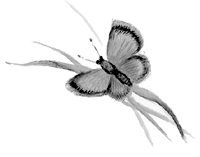 Chesapeake
Spring...
Chesapeake
Spring...Pulls the Wool off Our Eyes
New Bay Times’ Sandra Martin and Betsy Kehne Meet Spring with Author-Painter-Naturalist John Taylor
 Chesapeake
Spring...
Chesapeake
Spring...
Pulls the Wool off Our Eyes
New Bay Times’ Sandra Martin
and Betsy Kehne Meet Spring with Author-Painter-Naturalist John Taylor
Illustrations by John W. Taylor Photos by Betsy Kehne
The early maple, a giant of many years, spilled its pollen on February 7. A few days later, the hazelnut’s tight catkins opened like Shirley Temple curls.
 Meanwhile, outside
our bedroom window, birds come in multitudes to breakfast. We’ve got
the Fairhaven Cardinals out there, ready for a pick-up game against the
Owings Bluejays. As well as the usual crowd of sparrows, doves, titmouses,
chickadees and a red-bellied woodpecker are some long-time-no-seeums: two
cowbirds this morning, a red-winged blackbird and a gleaming grackle. The
latter must have flown over from North Beach, ahead of the flock that devoured
my friend’s suet the last Sunday in January. When I stop to listen,
the air outside is alive with bird cries.
Meanwhile, outside
our bedroom window, birds come in multitudes to breakfast. We’ve got
the Fairhaven Cardinals out there, ready for a pick-up game against the
Owings Bluejays. As well as the usual crowd of sparrows, doves, titmouses,
chickadees and a red-bellied woodpecker are some long-time-no-seeums: two
cowbirds this morning, a red-winged blackbird and a gleaming grackle. The
latter must have flown over from North Beach, ahead of the flock that devoured
my friend’s suet the last Sunday in January. When I stop to listen,
the air outside is alive with bird cries.
Still, having lived many winters in the cold Midwest, I’m suspicious
of spring. Early believers, like early blooming magnolias, suffer frosty
disappointments.
My heart is hardened to spring’s early messengers. Or was, until I listened to the soft voice of John W. Taylor, who taught me that I wasn’t in Illinois anymore.
By late February, the male redwings are in full voice, proclaiming territorial rights even before their mates have returned from the south. Others of their kind are migrating north, straggling flocks winging across the late afternoon skies. These blackbirds, along with the grackles, are perhaps the earliest migrants to appear along Chesapeake’s shores …
Taylor, who looks on the happenings of Chesapeake Bay from Pennington Pond on the Mayo peninsula, is as alert as Demeter (waiting half the year for her daughter Persephone) to the coming of spring. That season, he writes, is --
that segment in the earth’s orbit in which the natural world awakens, a season of dramatic change and spectacular migrations, of growth and flowering, of hatching and birthing.
In half a century of close observation, Taylor came to know spring so well that he wrote -- and illustrated -- the book on the subject. Taylor’s Chesapeake Spring was released last year by Johns Hopkins Press. Almost as beguiling as the season itself is that lovely earth journal.
Reading it, I want more. So does artist-photographer Betsy Kehne. We arrange to meet Taylor in late February to seek the spring beyond the pages of this enchanting book.
How did you become attuned to the messages of spring, I ask. Do you call yourself a naturalist? I wonder.
My question is a little like asking the pope if he believes in God. On this bright afternoon, Taylor has greeted us with a pan of cracked corn. Wearing pressed jeans, a sweater against February’s nip and rubber boots, carrying binoculars and a 30-power telescope, he is brimming over with delight at the treat he has in store: a feast of swans and mallards with a couple of surprise visitors, a black duck and an unusually trusting pair of hooded mergansers.
"Yes," Taylor answers slowly, considering, his blue eyes alight. "I think that would be fair. But I never studied in school. I learned by observation.
"I’ve been birding since fourth grade. Back then the Audubon Society was very active in the schools, providing materials. My fourth-grade school teacher, Katherine Scribner, was very encouraging.
"I saw that same teacher many years later -- ran into her in Ocean City, she was still birding -- and told her how much she meant to me."
Birding remains his abiding love. Taylor’s first book, The Birds of Chesapeake Bay, is drawn, literally, from his journals recording 40 years of birding.
But, says he, "If you’re bird watching, you notice a lot of other things." Which led, over the years, to Taylor’s second book, Chesapeake Spring. "One of the things my publisher, Johns Hopkins University Press, liked about that one," says Taylor, "was that it included so many different animals." That’s 140, including fish and amphibians. Flowers, trees and fungi add about 65 more to the cast of Chesapeake Spring.
Chesapeake’s long, diverse spring is different from spring any other place on earth:
To the miracle of spring, the Chesapeake lends a special amalgam of climatic, geographic and natural features, Taylor writes.
Lying midway between the sources of cold polar air and warm tropical masses, the Bay is continually charged with the tensions between these extremes. … This conflict between warm, active southern air and cold, heavy winds from the north stubbornly resists any gentle, regular turn of the seasons. When the Bay area is favored by a strong, southerly flow of air, temperatures may reach 60 degrees in January; wind from a northern quarter can, with no mercy, change April to December. …
One could hold with good cause that there are not four seasons at all in this part of the world, but only two, spring and fall. For one half of the year, the days become progressively longer; during the other half, the amount of daylight lessens. …In Chesapeake latitudes, the first day of winter might well count as the first day of spring. Already there are indications of an awakening, a renewal, despite the extreme cold or deep snow that is to come.
In the Midst of Winter …Dec. 26: West River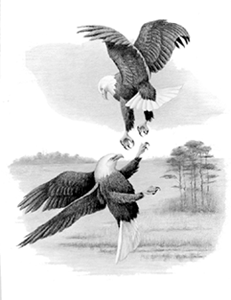
A shrill cackling from above shattered the calm. I looked up just as an eagle folded its wings and plummeted earthward. After falling several hundred feet, it threw out its legs and flared up into the path of another eagle. The two tumbled together awkwardly for a moment, then recovered composure as they gained altitude. Tracking slow, lazy circles in the blue, they came together several times, almost brushing wings. …
The eagles did not call again, but that brief interplay marked a turn toward the season of birth and renewal.
Of course, spring is not supposed to begin until March 21, when the vernal equinox balances the hours of darkness and light. Our Gregorian calendar, a 16th-century revision of the Roman calendar revised by Julius Caesar, seems more in sync with the rhythms of Chesapeake Country putting, as it does, the beginning of the year at the beginning of our spring.
"It is a little confusing," Taylor allows.
Still, the heralds of Chesapeake spring sometimes sing a familiar tune:
January 17: Beverly Beach County Park
From the murk emanated a serene, melodious murmur, barely audible. The warmth had stirred a troupe of wintering robins to song, their voices breathing an inexpressible sweetness and clarity. Tinged with melancholy, the subdued strains radiated a sense of joy, of well-being. …
The singing birds were pausing from their primary concern of the season: finding enough to eat. …
But the singing was not casual or incidental. At intervals, each flew in turn to the topmost branches of an oak, where, relaxed and unhurried, it joined others in this quiet, deliberate caroling. …
Other messengers are rare: invisible except to patient watchers with peeled eye and silent step.
February 4: Sellman Creek
Tidal action had opened the ice along the shoreline, the water there
reflecting the color of the sky. But most of the creek was still frozen.
… A rolling trill overhead, with the tone and quality of a shorebird,
was probably the call of a wintering dunlin.
Another sound from across the far shore I could not identify: a mysterious
yelp, followed by a raucous squalling. …
Moments later, across the frozen whiteness scampered a red fox. Near the far shore but in plain sight it hurried, crossing a road cove. It trotted nimbly over the slippery surface, a sensuous joy in its motion, in the deliberate contact it made with the earth and in the way its tail, held high, flowed behind. …
It stopped to urinate twice. … Was this the vixen, marking her
territory or leaving a trail her mate could follow?
The young are conceived in January and February in these parts …
For the foxes, it was spring in snowy February.
You must have thought yourself lucky to see the fox, I said to Taylor.
"Yes," he answered. And luckier still to later see her cubs."
Taylor enjoyed that rare sight -- "an active den in the middle of an open grassy slope" -- in late May. The den from which three cubs watched was, he wrote, "less than half a mile from where … in the gloom of a February dusk … I had heard the eerie, catlike screaming of mating foxes."
February 13: Pennington Pond
In dark swirling drifts, a battalion of large black birds descended into the backyard and settled into the adjacent trees. They swarmed over the lawn and the feeding shelves, their raucous clamor cutting through the afternoon chill. The grackles were back!
The first birds to return from the South are not robins or bluebirds. And not the honking echelons of Canada geese, which signal to many the end of winter. No, they are the common grackles, a noisy, squabbling, ubiquitous species some would call vulgar. …
Sometimes, spring’s harbingers are so familiar we hardly notice them. Like Walsh in North Beach, we see a grackle as no more than a grackle. Like neighbor Peters in Fairhaven, we hear the life-song of the peepers -- and wish they’d shut up so we can get to sleep.
February 24: Patuxent River County Park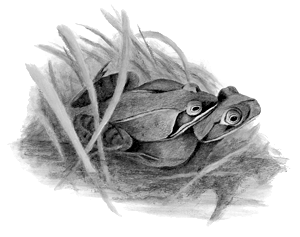
The din rose from a shallow depression filled with rain and melt water. Nearing the pool, I could also hear the croaking of wood frogs, cacophonous and grating but not as shrill or as loud as the calls of the peepers. At closer range it sounded much like the soft clucking of contented hens. Breaking the surface all around were bulging eyes and frog snouts. The water swirled with movement, forming spreading circles and ripples. All I could find at first were wood frogs; the peepers were but voices in the bog.
Some frogs floated passively, while others darted away with strong thrusts of long, thin legs. Many embraced in pairs …
Spring Is with Us
What, I ask Taylor, should people be looking for as March roars in?
"The tundra swans haven’t gone back to Alaska yet," he says. Come to Pennington Pond, he suggests, and I will see for myself.
Hooting, Taylor descends the slope and, in high boots, wades into Pennington Pond. By the handful, he tosses cracked corn and soon he’d caught the swans’ attention. A flock of two dozen of the huge, sleek, pure white birds come swimming to surround him. Others come by air, soaring in twos and threes (and once in nines) overhead, their feet tucked neatly into the fuselage of their great white bodies.
The swans -- and mallards -- are rising to John Taylor’s call.
"It takes them a while to make their landing they’re so big," Taylor notes. Just before they hit the water, the white giants drop from a horizontal plane to diagonal, and, feet forward, break for landing. Like their bills, their legs and feet are ebony black. Hitting the water first, their feet are enormous.
"They start howling before they’ve landed," says Taylor, who’s made a study of their calls. "That’s their greeting, and, see, the others are going over to greet them."
Soon, the water is boiling with three dozen swans, a chaos of huge white bodies twisting and turning, rising up to full height on beating wings in the competition for corn. The water is a little deeper than the range of their long, agile necks, so they dabble, dipping upside down to pick the kernels from the bottom. Hearing the constant chatter from afar, swans keep coming, scuttling in.
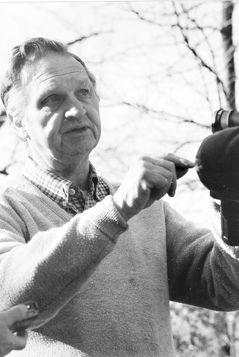 "They come to us each
fall all the way from northwestern Alaska, crossing North America [in a
kind of reverse S pattern]," Taylor explains.
"They come to us each
fall all the way from northwestern Alaska, crossing North America [in a
kind of reverse S pattern]," Taylor explains.
"Have you seen any with the black neck bands with white writing? Those are banded here. The white bands are from Alaska. There was one -- K264 -- banded here that they found up on the Arctic slope. He came back two years in a row. I haven’t seen him lately. I hope the band just wore off."
The six-month-long visit of tundra swans to Chesapeake Country will cost Taylor nearly $400: that’s three bags a week of cracked corn at about $15 each bag.
March 11: South River
Just before nightfall, from very high over the Bay, fell a faint murmuring, barely audible. Tundra swans migrating! Mellowed by the distance, the haunting sound grew louder as the birds came nearer and became more of a yelping whoop. One could feel the tense excitement in their voices, as if they sensed the import of the moment. It was the first stage of a journey that would eventually take them within the Arctic Circle. …
Spring comes to the other creatures of Chesapeake Country as an irresistible urge. Is it like that for Taylor, too, I wonder. Does he feel a drive to be out of doors?
"Being outdoors I wouldn’t call a drive," he answers. "It’s more a refreshment, like recharging your batteries."
March 21: Triton Beach
At 3:05am, the tilt of the earth brought the sun in direct line with
the equator, officially bringing spring to the Northern Hemisphere. Temperatures
were mild, following a storm that moved in from the south with strong winds
and heavy rain. Whitecaps rolled across the Bay and even in the smaller
inlets and creeks. Extra high tides washed over marshes and shorelines.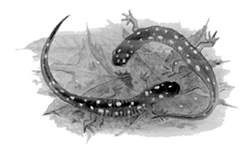
The warmth and moisture set the stage for a strange and ancient drama, one that has played every spring since Paleozoic times, since before the age of the dinosaurs. Such conditions give the biological cues that initiate the courtship and mating of that mysterious and beautiful creature of darkness, the spotted salamander. The performance opens annually, often for just a one-night stand, on the first warm, rainy night of spring. …
Taylor’s drive is painting.
That love, he tells me, is as old as birding, born in the fourth-grade class of Katherine Scribner, nourished by apparent chance.
"When I worked at the Smithsonian Institution as a young man," he recalls, "they were working on dioramas: stuffed real animals against a background of painted murals. I hung around them and that got me more interested. Then, around the age of 25, just before I went into the service, I realized I would never be happy except as a painter. In the service, I looked up artists I admired in Europe and America.
"Then when I got out of the army, I went to school at the Corcoran School of Art in Washington, D.C. But you don’t learn to paint birds."
Taylor had been observing and painting birds for years, much of his work for publication in other books, including the National Geographic Society, before he dared to devote himself entirely to observing and painting nature. Nowadays, except for a class he teaches at the Anne Arundel County Senior Center at Edgewater, that’s how Taylor spends most of his time. He’s interrupted many times a day when his cat, Peegee, wants to go in or out or -- from October into March -- when his swans call so loudly that he must feed them more cracked corn.
Taylor paints to suit himself and by commission, and displays his work in both wildlife shows and galleries throughout Chesapeake Country. His next show is the Patuxent Wildlife Art Show, coming to Harmony Hall Regional Center in Fort Washington on March 27 and 28 (10am-4:30pm both days).
Taylor’s paintings begin as observations recorded both in pencil sketches and on film. He takes several pictures from different angles to get different lighting. He doesn’t paint in nature because, he says, "there are too many bugs and things." In his studio overlooking Pennington Pond, Taylor makes his painting, choosing elements from his drawings and slides (projected onto a shadow-free box) until they’re just what he sees in his mind’s eye, which must be where he keeps his colors.
Usually he paints on canvas, and sometimes on masonite, but the paintings for Chesapeake Spring he made on paper, so, at the printer in Hong Kong, they could be wrapped around a drum for the best digitized color.
April 1: Flag Ponds County Park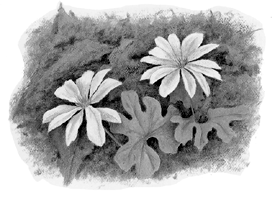
A bright but saturated morning, a world washed clean after a heavy downpour during the night. A south wind, warm and smelling of rain and moistened earth, spiced the air with the fragrance of spring.
Wildflowers scented the woods along the Ridge Trail overlooking the crowns of red maples in the swamp below. Bloodroot blossoms cascaded down a ravine, as thick and white as a snow drift. The flowers must have been brought to bloom by this morning’s sun. The wind and rain last night would surely have torn off the delicate petals, since they fall at the slightest touch …
By April, Chesapeake spring is clearly recognizable.
April 11: Jug Bay Wetlands Center
Unlike the names given to birds, those of butterflies are often as lovely as the creatures themselves. As opposed to birds named "sharp-shinned hawk," "old squaw" or "yellow-bellied sapsucker," we have the "dreamy dusky-wing," the "pearl crescent" and the "tawny emperor." Another happy and appropriate name has been given to one of our earliest butterflies, the spring azure.
A bit of color in the world still winter-drab, the tiny azure seems a creature from another world. With wings of purest blue, it emerges into a landscape of withered brown and muted gray. Early this afternoon, four of these elfin gems hovered about a woodland puddle. Like violets taken to wing, they fluttered restlessly, settling in pairs, then spiraling upward together. Separating, they fell back to earth …
Reading Taylor’s canticle to spring, it dawns that his writing is
as evocative as his drawings, combining close description, clear colors,
vivid name words, sensory triggers, metaphors and examples. How did you
become such a skilled writer? I ask.
"The only schooling that I’ve had," he answers, "is
in writing. I worked for a newspaper for a year. Then I was editor of Maryland
Conservationist, the state’s wildlife monthly, for six years, before
that magazine became Maryland magazine, which was eventually sold to a private
publisher."
April 22: Wye Island
Most of the fungi, especially the mushrooms, appear with the first warm rains of autumn. Then, suddenly, where there was none the day before, rises the familiar stalk and gilled cup of the agarics. Puffballs spring up on the lawn. The shelflike polypores reach maturity and cover stumps and dead snags. But the morels, perhaps the most sought after of all, come up in the spring.
A cluster of them pushed up their spongy heads here amid a thick bed of mayapples. Only two of them were well developed with stalks of an inch or more. Bits of the earth they had pushed through still clung to them. Most were just emerging from the leaf mold, with only their dark brownish crowns showing. The yellowish brown of the mature specimens identified them as yellow morels. …
Throughout our afternoon -- as throughout Chesapeake Spring -- Taylor
radiates delight in life -- and in a life well spent.
You said that as a young man, you realized you could not be happy unless
you were painting. You must be living a life that makes you very happy,
I ask.
"Oh, you’re getting very deep now," Taylor answers. "But yes."
May 8: Pennington Pond
Few Chesapeake fishermen respect the carp. To most, this sluggish bottom-feeder does little more than muddy the water and clog nets and traps. …
Carp hereabouts are transformed during the first weeks of May from drowsy, slow-moving fish to frenzied, powerful swimmers. In piscine ecstasy, several gathered today in the shallow water at the head of the pond, chasing, wallowing and wriggling. …
Pennington Pond is the backyard of this self-taught naturalist. It seems that one of the lessons of his book is that people can encounter nature right in their own backyards.
"You’d be surprised how many birds are in a backyard," he replies. "Here, I’ve counted 174 birds at different times I’ve seen since 1984. That includes birds way out over the Bay."
Readers might want to do their own earth journal. Can you tell them how you keep yours? I ask.
For Taylor, telling is showing. So the answer to this question takes us inside. His den is lined with books. On one wall, tall cases hold his collection of hundreds of books about birds. On the opposite wall, shorter cases hold his books about plants."Usually I would take a notebook along. After each trip, I would write it over, looking up any birds or plants I was uncertain of," the naturalist explains.
His earliest notebooks record trips with the Audubon Society, including
his first trip to Chesapeake Bay on Jan. 28, 1948. He documented those early
trips in neat lines spreading nearly to the margins of sheets of now-yellowed
paper, punched and preserved in three-ring binders. He has carefully and
neatly printed those journals, illuminating the initial capitals with drawings
of birds and waterfowl. "I can’t print like that now," he
says. Nor, he rues, does he have the pen he had then.
Neither is our Bay what it was then. "Those politicians who say they’re
bringing back the Bay, they don’t know what the Bay was," Taylor
mourns.
May 16: Choptank River at Dover Bridge
A flock of shorebirds, too small and distant to identify, whirled over, then changed course and eventually settled on the exposed mud. Restless, they had just begun to feed when a lone yellowlegs yelped a warning and all were up and off again. These little peeps, as they are known collectively, still had half a continent ahead of them. They must reach Arctic breeding grounds by early June if they are to complete the nesting cycle during the short northern summer. …
The old naturalist has won me over. No longer standing on temperature, no longer equating spring with mild days, I see signs and signals of the season everywhere. But will his theory hold up in June -- or on a steaming August day?
"I still think it’s only two seasons," Taylor says, "because the days are getting longer and longer and longer. Even though it’s going to get colder after Dec. 21, the days are getting longer. And then -- even though it’s going to get warmer after June 21 -- the days are getting shorter and shorter and shorter."
June 13: Tuckahoe Creek, by canoe
Summer here is a gentle fruition, the gradual attainment of promises made in spring. And in these latitudes, the fulfillment of such pledges does not wait for the solstice, for a specific day of the year. It is summer when the marshes are shoulder-high, when cattail spikes spill golden pollen, when the redwings bring off their first nestlings. …
Where will John Taylor next take us?
One likely destination, he says, is Chesapeake Autumn: "I am going to talk to the editors at Johns Hopkins.
"Another idea -- have you read Hulbert Footner’s Rivers of the Eastern Shore? It’s like you’re riding up the street, hardly anything about the plants and wildlife -- I’d like to do the rivers on both shores with their plants and wildlife. But that’s a big project …"
Intern Donna Ayres contributed to this story.
Editor’s note: Passages from Chesapeake Spring,
generously reprinted together with Taylor’s illustrations with the
permission of Johns Hopkins University Press, appear in italics.